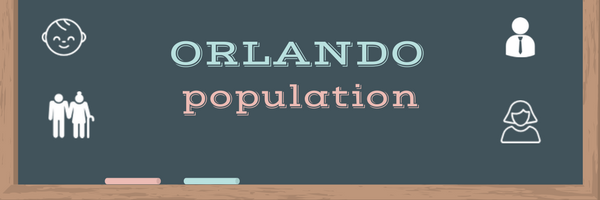
Orlando is a city of state Florida. The city has population over 300,000 that accounts for 1.3% of the state population. The city’s population is the fourth biggest in Florida after Jacksonville, Miami and Tampa. It is the 73rd-largest city in the United States and Florida’s largest inland city. Orlando is famously known as “The Theme Park Capital of the World”
Based on our research, Orlando population will reach 331,407 by 1st July of 2024. We use first day of July each year due to US census bureau normally publishes the estimated population data for the same period. The calculation is based on the average growth rate of 2.39% over last 12 years since 2011. We believe using the recent years’ figures (see the table in next section) will make the estimation more accurate.
Population Growth of Orlando
Looking back last twelve years of Orlando’s population, the growth rate is strong and consistent ranging from 2.02% to 2.92%, adding around 5,184 to 7,674 people each year to the overall population. Lots of workers were moving to Orlando to take advantage of employment opportunities there, which contributes to the population growth. Comparing with other cities in Florida, Orlando growth rate is above the state average. It is one of fastest growth major cities in US.
| Year | Population | Growth rate |
| 2011 | 243,883 | n/a |
| 2012 | 250,416 | 2.68% |
| 2013 | 255,600 | 2.07% |
| 2014 | 262,809 | 2.82% |
| 2015 | 270,483 | 2.92% |
| 2016 | 277,173 | 2.47% |
| 2017 | 284,260 | 2.56% |
| 2018 | 290,612 | 2.23% |
| 2019 | 297,982 | 2.54% |
| 2020 | 304,180 | 2.08% |
| 2021 | 310,937 | 2.22% |
| 2022 | 317,230 | 2.02% |
| 2023 | 323,680 | 2.03% |
Demographics of Orlando
According to U.S. Census Bureau, 48.6 percent of the Orlando population is male and 51.4 percent are female. The average resident age is 33, which is younger than other major cities in Florida. In terms of age distribution, the city’s population was spread out with 12.0% under the age of 18, 5.7% from 18 to 24, 27.3% from 25 to 44, 18.6% from 45 to 64, and 36.3% who were 65 years of age or older.
The top race groups for people living in Orlando are: White(75%),Black(25.1%),Asian(3.8%),Native(0.4%),Two or more races(3.4%).
The top languages (other than English) spoken in Orlando are Spanish (16.0%), Haitian Creole (1.93%), French (1.33%), Portuguese (0.99%), Arabic (0.54) and Asian Languages (1.9%).
In terms of resident wealth, according to research done in 2015, median household income in 2015: $44,804 (it was $35,732 in 2000). Per capita income in 2015: $27,069 (it was $21,216 in 2000). Median house or condo value in 2015: $214,400 (it was $97,400 in 2000).
Population Density of Orlando
Orlando’s population density is 1,017 people per square kilometer, which is one of the most populated cities in Florida.
Facts About Orlando
- Church Street Station, also known as the Old Orlando Railroad Depot, was built in 1889 and is listed on the National Register of Historic Places. SunRail now has a stop nearby.
- The tallest building in Orlando is the SunTrust Center at 441 feet.
- The Orlando area was originally the main hub of Florida’s citrus industry. After a disastrous freeze right before the 1900s, farmers began moving their citrus crops south.
- Before being known by its current name, Orlando was called Jernigan after the first permanent settler in the area.
- The City of Orlando has had 32 mayors. The first Mayor of Orlando was William Jackson Brack in 1875.
- Likely between 350 and 400 years old, the oldest tree in Orlando is located at Big Tree Park on North Thornton Avenue.
- As one of the world’s most visited tourist destinations, Orlando’s famous attractions form the backbone of its tourism industry.
- Orlando, as Florida’s largest inland city, became a popular resort during the years between the Spanish–American War and World War I.
References
The following links provide data for this topic:
- U.S. Census Bureau: https://www.census.gov
- Florida Government: http://www.myflorida.com/
- Orlando City Government: http://www.cityoforlando.net/
